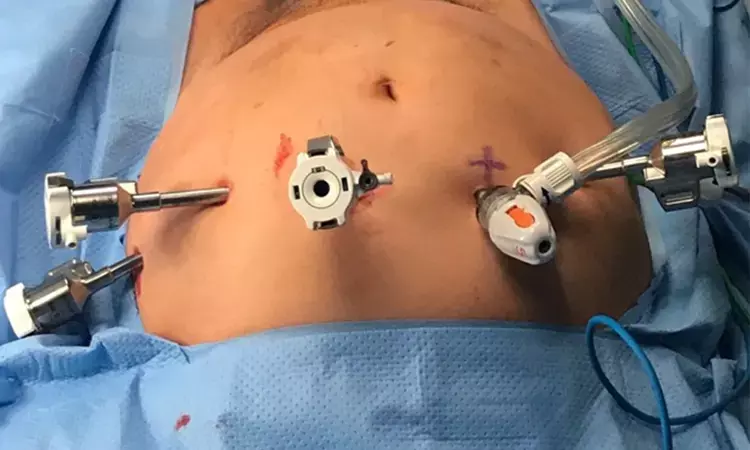- Home
- Medical news & Guidelines
- Anesthesiology
- Cardiology and CTVS
- Critical Care
- Dentistry
- Dermatology
- Diabetes and Endocrinology
- ENT
- Gastroenterology
- Medicine
- Nephrology
- Neurology
- Obstretics-Gynaecology
- Oncology
- Ophthalmology
- Orthopaedics
- Pediatrics-Neonatology
- Psychiatry
- Pulmonology
- Radiology
- Surgery
- Urology
- Laboratory Medicine
- Diet
- Nursing
- Paramedical
- Physiotherapy
- Health news
- Fact Check
- Bone Health Fact Check
- Brain Health Fact Check
- Cancer Related Fact Check
- Child Care Fact Check
- Dental and oral health fact check
- Diabetes and metabolic health fact check
- Diet and Nutrition Fact Check
- Eye and ENT Care Fact Check
- Fitness fact check
- Gut health fact check
- Heart health fact check
- Kidney health fact check
- Medical education fact check
- Men's health fact check
- Respiratory fact check
- Skin and hair care fact check
- Vaccine and Immunization fact check
- Women's health fact check
- AYUSH
- State News
- Andaman and Nicobar Islands
- Andhra Pradesh
- Arunachal Pradesh
- Assam
- Bihar
- Chandigarh
- Chattisgarh
- Dadra and Nagar Haveli
- Daman and Diu
- Delhi
- Goa
- Gujarat
- Haryana
- Himachal Pradesh
- Jammu & Kashmir
- Jharkhand
- Karnataka
- Kerala
- Ladakh
- Lakshadweep
- Madhya Pradesh
- Maharashtra
- Manipur
- Meghalaya
- Mizoram
- Nagaland
- Odisha
- Puducherry
- Punjab
- Rajasthan
- Sikkim
- Tamil Nadu
- Telangana
- Tripura
- Uttar Pradesh
- Uttrakhand
- West Bengal
- Medical Education
- Industry
Robot Assisted redical cystectomy reduces short-term morbidity and is cost effective

Robot Assisted redical cystectomy reduces short-term morbidity and is cost effective suggests a new study published in the JAMA Network Open.
The value to payers of robot-assisted radical cystectomy with intracorporeal urinary diversion (iRARC) when compared with open radical cystectomy (ORC) for patients with bladder cancer is unclear. A study was done to compare the cost-effectiveness of iRARC with that of ORC.
This economic evaluation used individual patient data from a randomized clinical trial at 9 surgical centers in the United Kingdom. Patients with nonmetastatic bladder cancer were recruited from March 20, 2017, to January 29, 2020. The analysis used a health service perspective and a 90-day time horizon, with supplementary analyses exploring patient benefits up to 1 year. Deterministic and probabilistic sensitivity analyses were undertaken. Data were analyzed from January 13, 2022, to March 10, 2023.
Patients were randomized to receive either iRARC (n = 169) or ORC (n = 169). Costs of surgery were calculated using surgery timings and equipment costs, with other hospital data based on counts of activity. Quality-adjusted life-years were calculated from European Quality of Life 5-Dimension 5-Level instrument responses. Prespecified subgroup analyses were undertaken based on patient characteristics and type of diversion.
Results
A total of 305 patients with available outcome data were included in the analysis, with a mean (SD) age of 68.3 (8.1) years, and of whom 241 (79.0%) were men. Robot-assisted radical cystectomy was associated with statistically significant reductions in admissions to intensive therapy (6.35% [95% CI, 0.42%-12.28%]), and readmissions to hospital (14.56% [95% CI, 5.00%-24.11%]), but increases in theater time (31.35 [95% CI, 13.67-49.02] minutes). The additional cost of iRARC per patient was £1124 (95% CI, −£576 to £2824 [US $1622 (95% CI, −$831 to $4075)]) with an associated gain in quality-adjusted life-years of 0.01124 (95% CI, 0.00391-0.01857). The incremental cost-effectiveness ratio was £100 008 (US $144 312) per quality-adjusted life-year gained. Robot-assisted radical cystectomy had a much higher probability of being cost-effective for subgroups defined by age, tumor stage, and performance status.
In this economic evaluation of surgery for patients with bladder cancer, iRARC reduced short-term morbidity and some associated costs. While the resulting cost-effectiveness ratio was in excess of thresholds used by many publicly funded health systems, patient subgroups were identified for which iRARC had a high probability of being cost-effective.
Reference:
Dixon S, Hill H, Flight L, et al. Cost-Effectiveness of Robot-Assisted Radical Cystectomy vs Open Radical Cystectomy for Patients With Bladder Cancer. JAMA Netw Open. 2023;6(6):e2317255. doi:10.1001/jamanetworkopen.2023.17255
Dr. Shravani Dali has completed her BDS from Pravara institute of medical sciences, loni. Following which she extensively worked in the healthcare sector for 2+ years. She has been actively involved in writing blogs in field of health and wellness. Currently she is pursuing her Masters of public health-health administration from Tata institute of social sciences. She can be contacted at editorial@medicaldialogues.in.
Dr Kamal Kant Kohli-MBBS, DTCD- a chest specialist with more than 30 years of practice and a flair for writing clinical articles, Dr Kamal Kant Kohli joined Medical Dialogues as a Chief Editor of Medical News. Besides writing articles, as an editor, he proofreads and verifies all the medical content published on Medical Dialogues including those coming from journals, studies,medical conferences,guidelines etc. Email: drkohli@medicaldialogues.in. Contact no. 011-43720751


